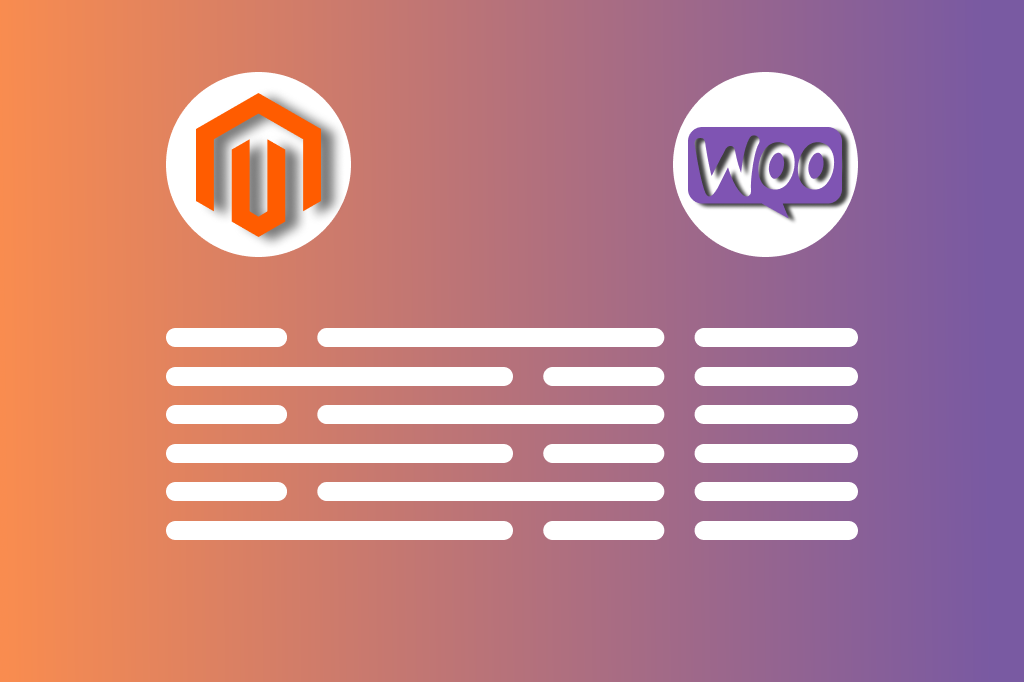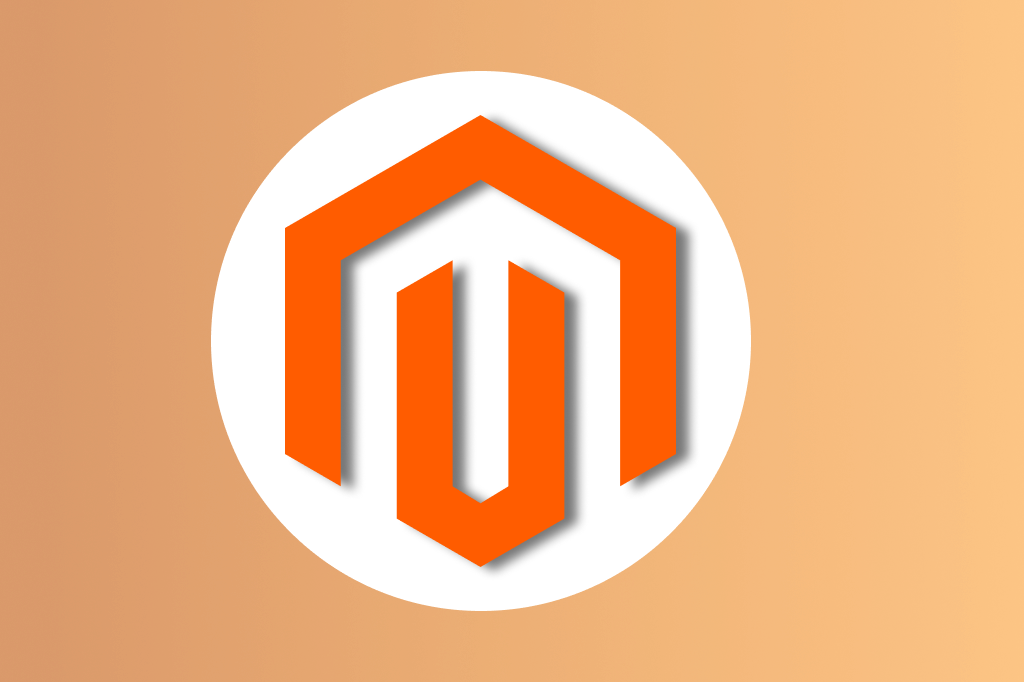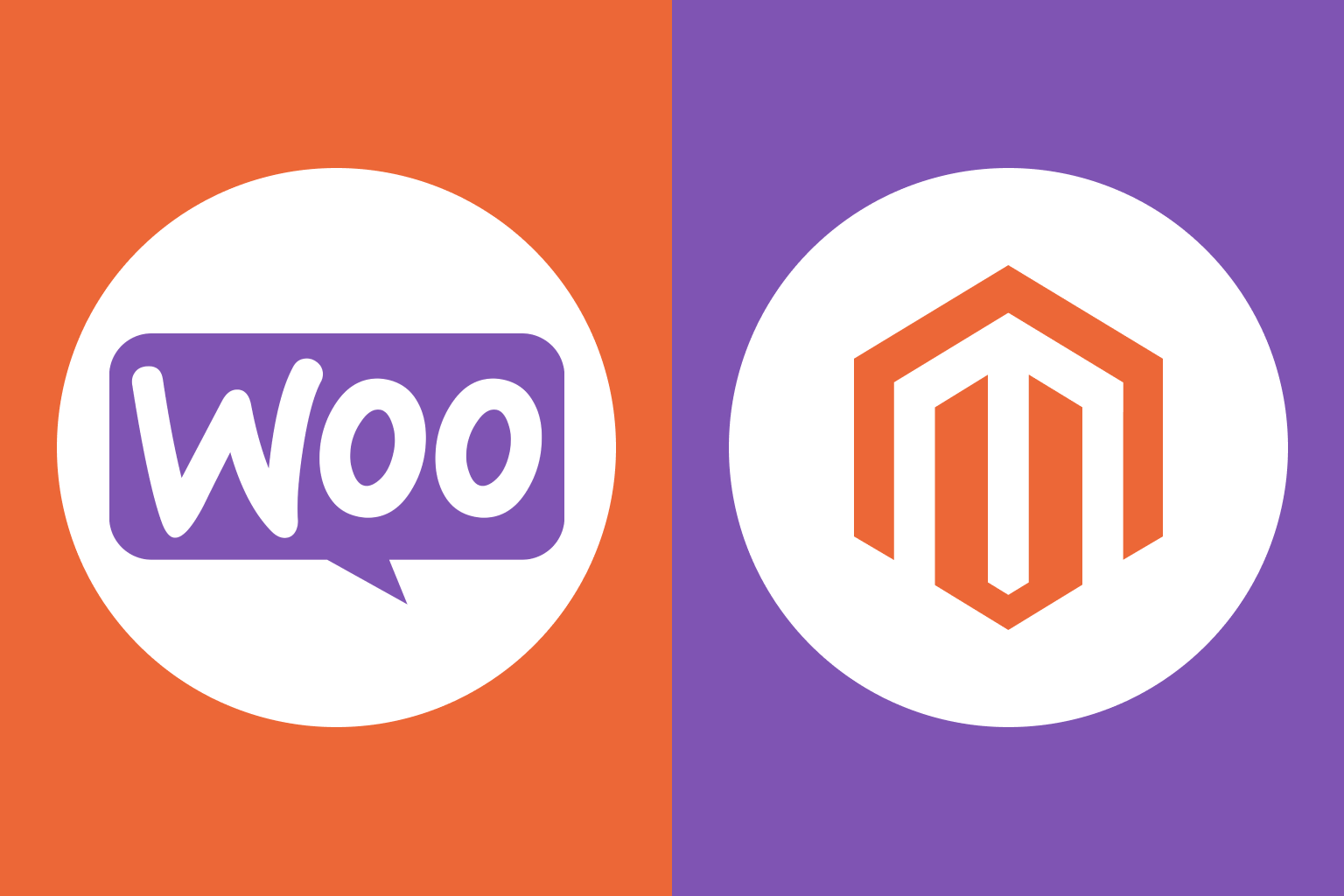Every entrepreneur is faced with the challenge of choosing a platform for their business. Whether it’s starting a business journey or moving from one solution to another. This process is always associated with difficulties and pitfalls that every businessman should be aware of. You should know a lot about the solutions you choose from: their characteristics, pricing, functionality, expansion prospects, and much more. In addition, platforms are improving every year, so the one you admired a year ago is lagging behind its competitors. Today, only two famous platforms are battling each other for customer attention: WooCommerce and Magento. And we can say with full confidence that without certain knowledge baggage, it is a tough challenge to choose any of them. In this article, we’ll confront two giants of online sales with each other and check which one is the ultimate solution for organizing your business. So, without further ado, let’s begin our battle.
Table of Contents
Magento
Magento is the pride of Adobe and is a complete e-commerce tool aimed at developing medium and large businesses. Currently, Magento has 1.1% of the market for all websites. One of the platform’s achievements is cooperation with world-famous brands. These solutions are praised and used by such large companies as Ford, Liverpool FC, Landrover, Jaguar, Christian Louboutin, etc.
All customers can pick between these versions:
- Magento Open Source: It’s free-of-charge Magento intended to be installed on separate hosting and perfectly suits small online stores.
- Magento Commerce: A full-fledged paid version targeted at medium and large stores. This version has two options for hosting – on a local device or using cloud technologies.
Magento is a solution for advanced users, and an e-commerce beginner without great technical skills is unlikely to launch a store without the assistance of experienced specialists. However, the user experience requirements are fully rewarded with Magento’s incredible flexibility, customization, and scalability. The combination of these advantages is one of the main Magento fame drivers.
WooCommerce
WooCommerce is a separate plugin for WordPress, and according to analysts, it supports over 28% of all stores today.
If we take it apart, WordPress serves as the basis for the future business, and WooCommerce is installed on top of it, which includes the necessary functionality for launching a business. Furthermore, it keeps up with Magento in terms of the well-known brands that utilize it. Famous brands like Good Dye Young, Weber South Africa, Wakami, Little Giant, and many others use this plugin.
However, why is WooCommerce such a popular tool? There are several reasons for this:
- Cheapness. To put it more precisely, it’s free, which opens the field of e-commerce to many entrepreneurs.
- User-friendliness. The platform is easy to learn, utilize and modify. Nobody denies that if you require custom functionality, you need to contact an experienced engineering team. However, all the basic customization of the platform is quite simple and does not require any special technical skills.
- Good support. Two past reasons have formed a user base. Now it’s quite easy for any WooCommerce newbie to find answers to all questions since there are countless forums on the Internet where other entrepreneurs will always answer and suggest.

Magento vs WooCommerce Features Comparison
So, after getting to know these solutions a little closer, it’s time to make our comparison. We will compare Magento vs Woocommerce according to essential criteria that entrepreneurs are most concerned about when migrating WooCommerce to Magento and vice versa. Let’s begin.
Pricing Policy
The first point of our comparison is what worries all entrepreneurs in the first place, namely the platform’s price. For the sake of the purity of the experiment, we’ll not consider third-party costs such as hosting, themes, etc., but we’ll take the net costs of the solution.
As we mentioned earlier, Magento provides a completely free Magento version. At the same time, the more advanced Magento Commerce (Enterprise) and Magento Commerce Cloud (Enterprise Cloud) costs between $22,000 and $40,000, respectively. The price depends on the gross merchandise value and can be discussed with the vendor when concluding a deal.
Meanwhile, WooCommerce is chargeless. Just implement it into your website, and you are ready to go.
User-Friendliness
Magento is an incredibly flexible and multifunctional solution. For instance, when adding goods, it allows you to fill in various fields to make the product page as informative as possible. However, such a broad functionality set plays a cruel joke with the ease of mastering. And this is just one example.
Meanwhile, WooCommerce has a minimalist design that’s easy to onboard. Shortly speaking, its learning curve is rather flat, which influenced the overall growth in popularity. In this aspect, you must pick between broad capabilities you must understand or more modest functionality you can master quickly.
Functionality Set
Next up in our Magento vs WordPress WooCommerce comparison is discussing the feature set that comes out of the box. For greater clarity, we decided to combine everything into a convenient table to immediately see what functionality is present or absent in a particular solution.
| Functionality | Magento | WooCommerce |
| Physical products | ✔️ | ✔️ |
| Variable products | ✔️ | ✔️ |
| Digital products | ✔️ | ✔️ |
| Shopping carts | ✔️ | ✔️ |
| Checkout and payments | ✔️ | ✔️ |
| Coupons and discounts | ✔️ | ✔️ |
| Shipping calculations | ✔️ | ✔️ |
| Taxes | ✔️ | ✔️ |
| Order fulfillment | ✔️ | ✔️ |
| Analytics | ✔️ | ✔️ |
| Mobile app | ❌ | ✔️ |
So, what do we have in the end? Our two competitors include all the necessary functionality to start developing a business immediately after deployment. However, we want to make a small addition:
Even though we indicated that Magento does not have a mobile application, we meant the official one. You can install an unofficial mobile application in which you cannot manage the store, and no one can vouch for its correct operation.

Shipping Management
Organization of delivery is another criterion by which entrepreneurs choose a platform for their business. Creating multiple shipping options plays an important role in providing an enjoyable shopping experience to customers. In this paragraph, we’ll also collect all the options for both solutions into one table.
| Shipping option | Magento | WooCommerce |
| Managing classes | ✔️ | ✔️ |
| Managing zones | ✔️ | ✔️ |
| Table rate shipping | ✔️ | ✔️ |
| USPS rates | ✔️ | ✔️ |
| FedEx rates | ✔️ | ✔️ |
| Pickup | ✔️ | ✔️ |
By this criterion of WooCommerce vs Magento comparison, they’re on par. You can rest assured of delivery flexibility, whatever your pick will be.
Extensions and Add-ons Quantity
The basis for the initial customization of platforms is various extensions created by the vendor, third-party developers, or simple craftsmen from the user base. And this topic is worth diving into a little better, as this is where the main difference between WooCommerce and Magento starts shining out.
Magento extensions are available in the official Magento store. Currently, the variety exceeds 3800 extensions related to changing the interface, adding new functionality, and so on.
In turn, WooCommerce is significantly ahead of Magento in this aspect. Since WooCommerce is a WordPress plugin, all existing WordPress plugins are added to the variety, which expands the possibilities for customization. Thus, there are over 58 thousand different plugins on the official website.
Themes Variety
Pre-made themes are an excellent option to transform your store’s look for some holiday or if your path requires a design update. Each solution supports themes, and they’re available for download from both official websites and third-party ones. Nevertheless, there is a question of their quantity here again, and luck isn’t on Magento’s side.
The official Magento store currently has only 11 themes, while WooCommerce has over 1000 different themes available to the user. Yes, don’t forget about visual upgrades from third-party websites, and if you take them into account, then Magento has a total number of more than 1000 themes, but in this situation, WooCommerce goes into an even larger gap.
Customization Opportunities
In this aspect of our Magento e-commerce vs WooCommerce comparison, they are equal. Open-source solutions free the hands of store owners in terms of customization. If you have sufficient technical knowledge or a highly skilled development team, you can transform your store, add new functionality without any problems.
Customer Support
User support is not a strong point of open-source platforms. Therefore, you won’t see 24/7/365 support here. But you’re not alone since there’s always a dedicated community ready to assist you.
Both counterparts have large communities. However, support is dominated by WooCommerce due to its greater popularity. As a result, it will simply be easier and faster for you to find answers to your questions.
Payments
The next point of our overview is payments. The more gateways clients have at their disposal, the happier they are. That’s why it’s worth considering the possibility of implementing various payment gateways when picking solutions for business.
Magento supports all popular payment methods making this solution an ideal choice. However, its counterpart does not lag, and in addition to the standard methods, it offers its own WooCommerce Payments. For more clarity, we decided to present all options in the table below.
| Option | Magento | WooCommerce |
| No transaction fee | ✔️ | ✔️ |
| PayPal | ✔️ | ✔️ |
| Braintree | ✔️ | ✔️ |
| Stripe | ✔️ | ✔️ |
| Authorize.net | ✔️ | ✔️ |
| Custom integrations | ✔️ | ✔️ |
| Offline payments | ✔️ | ✔️ |
| Cryptocurrency | ✔️ | ✔️ |
SEO Options
This point of our overview is another WooCommerce and Magento difference. SEO is a must for your e-shop to get noticed in the search engine. And the more settings you have, the better. These solutions do a great job of powerful SEO customization. For instance, Magento supports the following settings by default:
- SEO titles
- Meta descriptions
- URLs
- XML sitemaps
- Canonical URLs
- Robots.txt files and much more.
You can find these settings in WooCommerce as well but you will need a third-party plugin to use them.

Magento vs WooCommerce Overview Table
So the grand finale of our comparison has arrived. For completeness, we decided to combine all the points mentioned above into a table to see the pros and cons of Magento vs WooCommerce. Each item, in addition to the verbal description, will receive an assessment on a five-point scale.
| Criteria | Magento | Score | WooCommerce | Score |
| Pricing policy | Paid (from $22,000) + free Open-source | 4/5 | Completely free | 5/5 |
| User-friendliness | Steep but rewarding learning curve | 3/5 | Easy to learn | 5/5 |
| Functionality set | Basic + advanced | 5/5 | Basic | 4/5 |
| Shipping | Wide-set of options | 5/5 | Wide-set of options | 5/5 |
| Number of extensions | 3,800 extensions on the official website. | 4/5 | WooCommerce extensions + WordPress extensions
50,000+ in total |
5/5 |
| Themes variety | The low variety on the official website but pretty descent on third-party websites | 3/5 | Enormous variety both on official and third-party websites | 5/5 |
| Customization opportunities | Limitless due to open-source core | 5/5 | Limitless due to open-source core | 5/5 |
| Customer support | Standard for an open-source solution | 4/5 | Standart for an open-source solution but easier to find answers due to higher popularity | 5/5 |
| Payments | Third-party only | 4/5 | Third-party + out of the box solution | 5/5 |
| SEO options | Wide options out of the box | 5/5 | Wide options only if specific plugins installed | 3/5 |
So, as you can see in this comparison table, both of these eCommerce tools have their own advantages and minuses. But a good development team can smooth things over and bring the best solution to your online shop.
Final Thoughts
After this Magento 2 vs WooCommerce comparison, we can say that all these solutions are worth trying out. Each one has its fors and againsts you must put up with. For instance, Magento is hard to deploy and master but provides great functionality for any size market. In the meantime, WooCommerce is perfect for newbies but offers more suitable functionality for small e-shops. And we hope we could give you a complete picture of these two solutions.
Also, these solutions lend themselves well to modification, and you definitely can’t go wrong with your pick. For instance, using our Sam-Ecommerce Magento e-commerce development services, you can add any functionality, any design to comply with your business vision. Just drop us a line, and our representatives will contact you to consult on your project.












Published in: